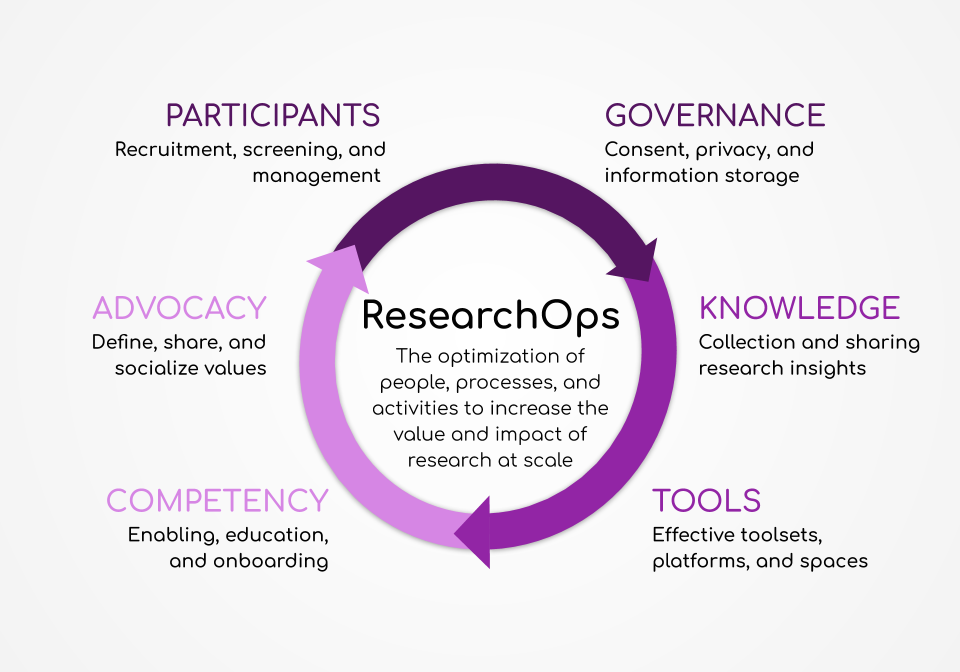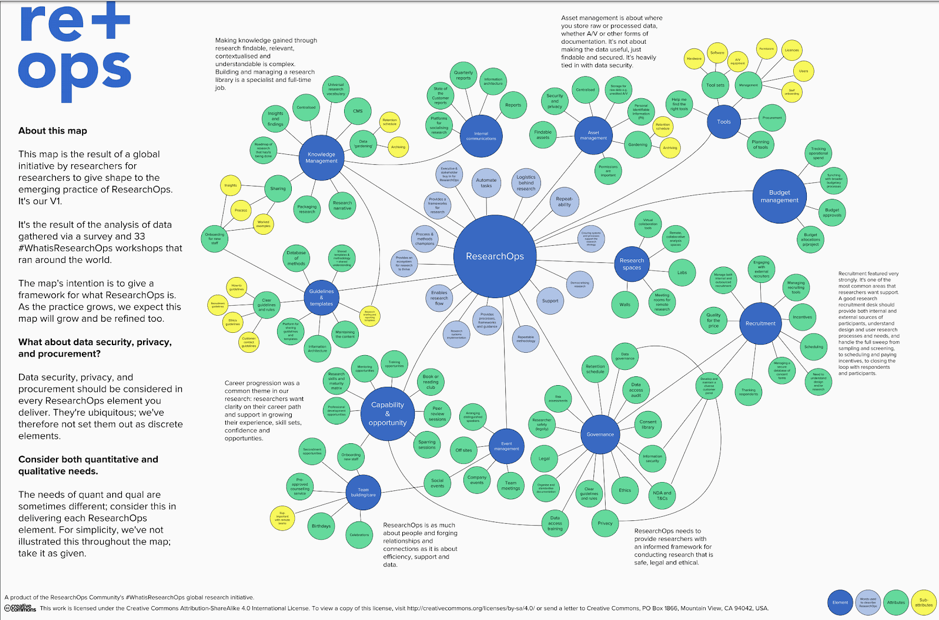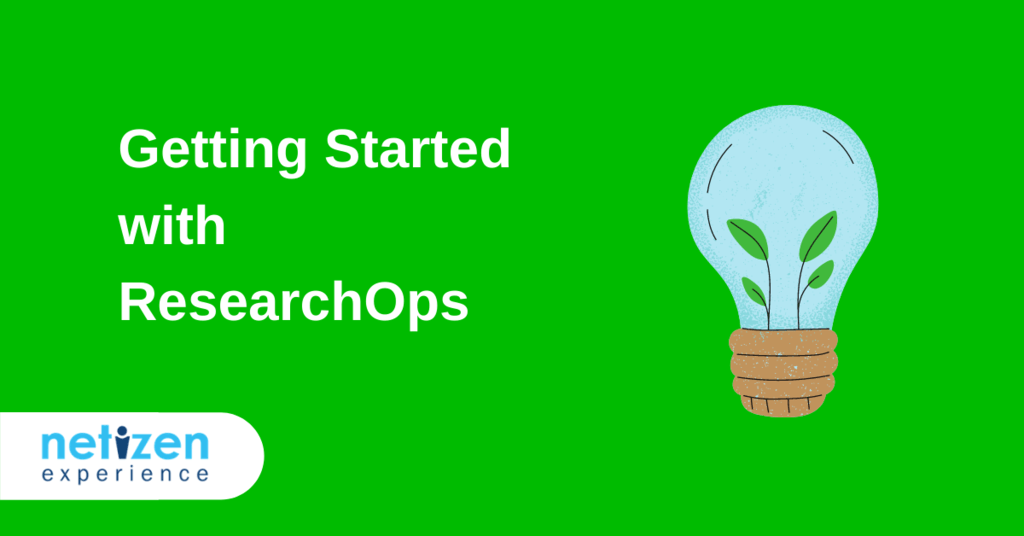[et_pb_section fb_built="1" admin_label="section" _builder_version="4.16" global_colors_info="{}" theme_builder_area="post_content"][et_pb_row admin_label="row" _builder_version="4.16" background_size="initial" background_position="top_left" background_repeat="repeat" global_colors_info="{}" theme_builder_area="post_content"][et_pb_column type="4_4" _builder_version="4.16" custom_padding="|||" global_colors_info="{}" custom_padding__hover="|||" theme_builder_area="post_content"][et_pb_text admin_label="Text" _builder_version="4.17.3" background_size="initial" background_position="top_left" background_repeat="repeat" hover_enabled="0" global_colors_info="{}" theme_builder_area="post_content" sticky_enabled="0"]
Research Operations (ResearchOps) focuses on measures and processes in supporting researchers for various research stages, which includes planning, conducting research and applying the quality research at scale.
ResearchOps is a specialized area that specifically focuses on elements of user-research practices. The optimization of people and processes helps to amplify the value and impact of the research being done. This includes:
- Standardization of research methods and supporting documents, such as scripts, templates & consent forms. This helps to save time and will enable consistency in applications across the team
- Recruitment and management of research participants
- Advocate research ethics, ensuring it is understood and upheld
- Educate research-team partners and those in leadership positions on the value of user research
- Management of user-research insights, ensuring that the data is accessible by the team and organization
- Socialize success stories in ensuring the overall impact of user research is evident
Here's what we will cover in this article for ResearchOps. You may continue to read on or skip to specific sections by clicking the links below:
- Why Does ResearchOps Matter?
- Components of ResearchOps
- Getting Started with ResearchOps
- Strategies to Manage the Administrative Burden of Research
Why Does ResearchOps Matter?
More and more companies are understanding the real value of user experience (UX), and with that, the demand for UX and user research is rising. With this, the practical aspect of scaling research practices falls on the responsibility of the existing UX research personnel, where they need to face the challenges of developing processes to scale in order to match the demand. All whilst at the same time, continuing to plan and conduct research sessions.
So if your company wants to do 10 times the amount of user research, the cost shouldn't just correspond accordingly. In fact, ResearchOps helps to decrease cost goals to 8 times or lower. It helps to provide relief with a focused effort in creating and compiling strategies and tools with the intention of managing the operational aspects of research. This way, the researchers can focus on what they do best, conducting research and applying the valuable research insights.
It is important to highlight that ResearchOps doesn't equate to participant management. Of course, participant recruitment and management does take time and effort, and is an important aspect of ResearchOps but it is not the only aspect. It is about building a plan for consistent quality throughout the entire process.
Components of ResearchOps
The ResearchOps model consists of 6 key focus areas:
- Participants: Recruitment, screening, scheduling, and compensation
- Governance: Processes and guidelines for consent, privacy, and information storage
- Knowledge: Processes for collection, synthesizing, and sharing of research insights
- Tools: Making use of consistent toolsets and platforms to enable efficient research
- Competency: Advocating, and educating others in conducting research activities
- Advocacy: Define and share the value of user research to everyone in the organization

This model is a cycle, the elements aren't isolated but in fact, are interrelated in driving the need for and influence of each other. Let's look into each individual key focus area for a better understanding:
Participants
ResearchOps in respondent management includes creating a streamlined process for the entire recruitment process: searching, recruiting, screening, scheduling and compensating the research participants. It is typically the most obvious and immediate need to avoid overloading the research team.
ResearchOps activities and efforts in participant management includes:
- Creating a database or a panel of potential participants or making use of an external recruitment platform
- Screening and selection of participants
- Communication management with participants
- Framework for fair incentive levels based on participant expertise and required time invested
Governance
Governance is an absolute necessity for any study that involves participants. Consent templates must be compliant to data-privacy regulations and must be written in plain language so that it's clear to participants.
In addition, since the participants' personal identifiable information is collected and stored, the organization must adhere to legal and ethical regulations and standardization on how the information is stored, how long for, how it must be protected. This information must also be made transparent and communicated to participants.
ResearchOps activities and efforts in governance includes:
- Researching, understanding, and adhering to data-privacy regulations
- Establish ethically sound communication and processes
- Standardization and writing of compliant and clear consent forms for various types of studies and formats of data collection
- Proper maintenance and disposal of personal identifiable information, interview scripts, session recordings and other forms of study artifacts.
Knowledge
Knowledge management focuses on the collection and synthesizing of data across research studies in ensuring that it's searchable and accessible to others in the organization.
Effective compilation and management of research insights not only helps the research team in sharing findings and in avoiding repetitive studies, it also aids in educating those outside the research team.
ResearchOps activities and efforts in knowledge management includes:
- Development of standardized templates for data collection
- Creating a shared database for research insights or research repository
- Develop regular meetings or other forms of communication to share and update the organization on user insights
- Coordination with other teams such as marketing or business intelligence that conduct research to create a comprehensive source of research insights
Tools
Toolsets and platforms are an important apparatus for the activities and efforts above, whether it's for recruitment, management of personal identifiable information, or research depository and database.
In addition, tools are required for UX research facilitation, especially for remote usability testing, data analytics, surveys, video editing or transcription tools.
Auditing the research toolsets and platforms helps to create a level of consistency throughout the team, and it expedites information sharing and collaboration.
ResearchOps activities and efforts in knowledge management includes:
- Research, comparison and selection of suitable platforms for recruitment and management of participant information
- Selection of research tools for usability testing, interviews, surveys and other forms of research
- Management of access privileges across individual user researchers and teams
- Auditing research toolkits in ensuring that all platforms and applications that are being used are compliant with data-privacy regulations
- Management of usability labs, which includes contracts for outsourced locations
Competency
Growing the organization's research capabilities and skills is vital as the demand and amount of research rises, this is where the competency element comes in. It is to enable more people in understanding and conducting research, and this effort often consists of providing resources and education to researchers in the continued development of their skills. This extends to nonresearchers, so that they are able to integrate basic research skills and activities into their normal line of work.
ResearchOps activities and efforts in knowledge management includes:
- Development of standardized and consistent professional-development opportunities
- Create mentorship programs in developing new research skills
- Establish a database of research methods for inducting new researchers and to educate nonresearchers
- Develop formal training for nonresearchers and educate them in user-centric approaches and activities, this way basic research can be easily done when researchers aren't available due to demand
Advocacy
This component is about how the value of UX research is communicated to the organization. Is everyone aware of the value and impact of research? Are success stories communicated in demonstrating the impact of user research?
Coming full circle on the cyclical nature of the model, proper advocacy aids in developing motivation and resources for research and other focus areas so that ResearchOps can continue to scale with effectiveness.
ResearchOps activities and efforts in advocacy includes:
- Defining a UX research mission statement that can be useful in discussing the team's purpose with those outside the team
- Development of case studies that can be used to demonstrate the impact of research findings when it has been properly applied to company KPI's and metrics
- Develop a process for regular insight sharing and success stories to the entire organization, this could be in the form of email newsletters, posters or a lunch-and-learn session.
Getting Started with ResearchOps
ResearchOps is an amalgamation of many parts that are best considered holistically as each element both affects and is affected by other elements. It is important to point out that when it comes to establishing ResearchOps, not all of the elements can be addressed at once.
The first thing is to establish priority, this can be done by understanding where the biggest pain points are. Is the research data scattered around and hard to find and access? Maybe knowledge management would be the best starting point.
Perhaps the researchers are being overwhelmed by participant recruitment and management? Maybe participant management is where the team should focus on first.
Identifying current problems is a good way to start, you can do this by performing internal research to understand the biggest pain points for the research team. Additionally, conducting internal stakeholder interviews helps to uncover the biggest pain points when it comes to partners within the research process. All of this valuable information will help in creating a clear role for ResearchOps.
Consider engaging an external independent research consultant to help in the entire process, Netizen Experience can complement your organization in running and supporting ResearchOps, benefiting from their many years of experience and dedicated UX researcher support.
An important point to remember: when it comes to scaling research, don't bite off more than you can chew. Engage adequate support so that your organization can focus on balancing the 6 key focus elements and to evolve and expand the focus accordingly as the needs shift, in order to maintain a balanced practice.
Strategies to Manage the Administrative Burden of Research
Research can be very admin-intensive, especially when it comes to respondent recruitment and user interviews, which is why ResearchOps is so important to implement to reduce the amount of admin workload. In implementing ResearchOps, there are some strategies that can be used to ensure things are being done in the most efficient way possible:
1. Know Your Limits
Knowing your limits comes with understanding what is expected of you; what your colleagues expect and what your organization expects from you. The key to running a research practice is knowing where the job of a researcher stops and where the jobs of the other team members begins.
A lack of communication and alignment will cause duplicate work, missed opportunities and more admin work.
2. Establish Clear Boundaries
The nature of research is consultative, and so requires input from various parts of the organization. If not properly managed, doing research without establishing clear boundaries can result in a significant amount of admin work.
Let's look at a typical research project:
- You may start by sitting down with stakeholders to find out what problems they want to solve or what questions they want answers to.
- Then, you might consult other researchers on your team to solicit their advice and opinions on how best to proceed.
- Perhaps you may conduct a pilot test with internal staff before going live and testing with target users.
- Depending on the research, there's a likelihood you will need to engage with the legal department in working through risk assessments, consent forms, risk and ethical issues.
- Towards the end of the project, the research will need to be stored and this will involve data governance.
The ResearchOps community has created this framework that maps out the majority of research processes. Looking at a typical research project, it's impossible to handle any bubble without touching many of the other bubbles. Which is why it's important to establish clear boundaries as to what you and other individuals should cover.

As for how these boundaries are actually established in reducing the chance of administrative overload into conversations, is to clear up any obscurities by simply gathering different parties and talking through your perspectives.
3. Outsource
Outsourcing can save a lot of headache and administrative load, this doesn't mean taking the entire research practice and outsourcing it as a whole but to take selected components that are well suited to be managed by third parties.
Participant recruitment is an obvious component that can be easily outsourced, especially because it is typically one of the most time-consuming and admin-heavy parts of the research process. It is also one of the easiest components to outsource. Participant recruitment services have a database containing a lot of potential participants, and they can help to recruit groups of participants that fit the recruitment criteria.
This eliminates the task of having to do it yourself, not having to go and manually search for participants. However, there will be times where you may need to personally recruit users, perhaps for extremely niche subject areas or if the participants are directly from your customer base.
4. Prioritize Your Research Repository
Establishing a research repository is a time commitment but the time taken to establish a useful and usable repository will be a good investment. In the long term, you will save time and reduce admin work because there's a clear process for storing research insights.
In addition, when a new project starts, you'll have a good place to start as opposed to going in blind and starting from scratch. The research repository will enable you to search through past studies to see if there has been any similar research that has been done. This way, you can maximise the use of past research, allowing you to focus on getting new research insights.
What a good research repository looks like:
- Easily retrievable: There should not be any barriers for researchers needing to access the research data.
- Traceable insights: Researchers should be able to trace the outputs of the research project to the raw research data and initial findings.
- Easily accessible: The repository should be fairly accessible to others in the organization, such as developers, designers or marketers.
- Secured or deleted sensitive data: Whilst the research repository should only be accessible by those within the organization, precautions need to be taken in order to avoid sensitive data leaking. This means securing sensitive data, if not deleting it when it's not essential to keep.
User research will always have a fair amount of administrative work, but by implementing these suitable strategies and ResearchOps, arduous and repetitive tasks can be minimized, allowing you to focus on what's important.
[/et_pb_text][/et_pb_column][/et_pb_row][/et_pb_section]





